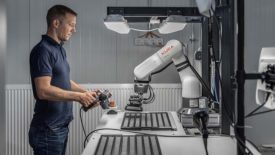Home » cobots
Articles Tagged with ''cobots''
Quality 101
As robotics use grows throughout processing, packaging, and logistics environments, it’s important to understand your options — and how to keep up with safety guidelines.
Read More
Robotics
New Scale Robotics Automates Gauging Applications With FANUC Cobots
Company named a FANUC authorized systems integrator.
August 27, 2024
Vision & Sensors | Cobots
Collaborative Robots Emerge as Viable Automation Options for SMEs
Benefits and key steps for a successful system design and installation
August 14, 2024
Vision & Sensors | Artificial Intelligence
Machine Vision and the Role of AI in Quality Control
AI-based inspection ensures consistent inspection performance, scalability, and data-driven decision-making.
August 13, 2024
Case Study
Creative Cobot Use Simplifies Product Testing
As the technology has progressed, many companies have discovered ways to reap the benefits of modern cobots beyond manufacturing and assembly operations.
June 25, 2024
Case Study
Remote Robot Monitoring & Control Slashes Downtime Costs
A new approach to remote robot monitoring and error recovery helps companies restart production faster in cases of unplanned robot downtime.
June 20, 2024
Vision & Sensors | Automation
Augmenting Your Workforce: Three Opportunities to Leverage Technology to Automate Repetitive Tasks
As with any good engineering approach to problem-solving, we can divide the manufacturing labor challenge into parts.
June 17, 2024
Quality Headline
Cobot Systems Announces UR+ Partnership with Laser Welding Cobot System
May 25, 2024
Quality in Automation | Robotics
Advanced Automation Delivers the Ultimate in Quality Control
When considering the type of robot for automating inspection tasks, cobots are often the initial go-to solution.
March 29, 2024
Stay in the know with Quality’s comprehensive coverage of
the manufacturing and metrology industries.
eNewsletter | Website | eMagazine
JOIN TODAY!Copyright ©2024. All Rights Reserved BNP Media.
Design, CMS, Hosting & Web Development :: ePublishing









